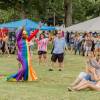On a blindingly bright morning, Paul Goldberg looked up a main street in downtown Newburyport, pointing out the route he helped plan for the small city's first Pride parade. This Saturday, the inaugural event will step off from the old court house.
“We’ll walk down Green Street to the end,” he said, turning to look north, “cross over to the waterfront there and walk along the boardwalk, just a short way into Waterfront Park.”
Just over a year ago, it’s an event that would’ve been a distant dream in the city of less than 20,000.
Last May, plans for a queer youth dance were thrown into chaos when the venue, a local Masonic lodge, abruptly pulled out less than two weeks before the event. The social organization’s statewide leadership had gone over members’ heads and called off the dance, seemingly over concerns about hosting an event for LGBTQ+ youth with a drag queen.
But just as quickly, Newburyport’s community responded with a rush of support . Five venues offered up their spaces. Locals put together a welcoming wall of neighbors, where more than a hundred people showed up to wave flags, celebrate and stand in solidarity with the high schoolers. And the Masonic lodge went against orders: they hosted the dance anyway.
It was a turning point for the city.
Beyond Newburyport, organizers in small towns and cities across Massachusetts are making a concerted push for their queer neighbors feel seen and supported in their own communities, without having to go to the nearest big city. And it’s an effort that’s taken on additional meaning amid a national rise in anti-LGBTQ legislation in state legislatures .
“After the ‘Over the Rainbow’ dance last May, we kind of reflected on everything that had happened — and the biggest takeaway was just this overwhelming outpouring of support from the community for our young people,” said Tarah MacGregor, who is now one of the Newburyport Pride board chairs.
“We were like, ‘OK, Newburyport needs a Pride, right?’” she said.

The nine-person committee in Newburyport, which had its first official meeting in December, is now putting the finishing touches on a dozen events, including a flag-raising with Gov. Maura Healey.
“Every time somebody attacks our kids, it backfires ... because the community comes back with more love and more support than we could ever have imagined,” said James Giessler, who leads NAGLY, the North Shore Alliance of GLBT Youth. It co-sponsored last year’s dance. “As we see in Newburyport, with all the ruckus that they had, now they’re going to have one of the most spectacular Pride observations on the North Shore.”
New Prides focus on celebration
The Pride celebrations popping up in smaller cities and towns often take cues from the original marches, which were political protests in major cities that go back 50 years to commemorate the Stonewall riots. But today, these smaller Prides focus more on celebration, promoting visibility and making residents feel safe. Newburyport is far from Massachusetts’ first Pride outside of Boston; it’s not even the first Pride on the North Shore.
Hope Watt-Bucci wanted to fight back against hate in her own community after she witnessed an older gay couple being mocked in a local restaurant and heard stories of homophobic taunts and assaults circulated on the North Shore. So, in 2012, she founded North Shore Pride and its first parade marched through Salem that June.
Watt-Bucci remembered thinking she’d be glad if a hundred people came to the group’s first event. “Thousands of people showed up,” she recalled. “And I thought that, ‘OK, yeah, we need to do this. We clearly need to do this.’”
Last year’s parade in Salem attracted 20,000 celebrants.
More Local News
Enough Pride celebrations have cropped up over the last decade that Watt-Bucci started what she calls the Rainbow Coalition, bringing together organizers from different North Shore celebrations.
She and a dozen other organizers gathered on a recent Tuesday evening at a Beverly restaurant. It was a logistics-dominated evening, talking through event insurance, food trucks and 501c3 paperwork. But the room often burst into applause as organizers reveled in the dozens of events that would be held in cities and towns across the North Shore in June: drag queen bingo in Wenham, youth Pride in Lynn and a flurry of flag-raisings.
This year, Topsfield is hosting Tri-town Pride for the second year with Boxford and Middleton — though it’s the first year they’ll have a parade — in response to a protest at a Boxford drag queen story hour last year. A formalized nonprofit is organizing Pride in Lynn for the first time. Revere will host its second annual “Beach Pride.” Wenham and Hamilton will have their third joint Pride picnic. Swampscott had its first Pride in 2020, and this year there’s a new addition: a “Run with Pride” 5k.
'Everybody's welcome' doesn't apply just to big cities
Parades and other celebrations are often just “the tip of the iceberg” of deeper changes in the towns that are hosting them, according to Kim Creasap, who researches small-town Pride events in the Midwest. She’s found Ohio towns where organizers are celebrating the passage of a local ordinance, scaling up the reach of local support groups or hoping that a big celebration could be an economic boon.
“There was actually a lot of advocacy behind the scenes leading up to Pride,” Creasap said, referencing those Midwestern cities and towns. “So, in other words, the Pride parades — or picnics, or festivals — were kind of a more visible consequence of a less visible community organizing that has been going on.”

Joan Ilacqua leads The History Project, which preserves archives of New England’s LGBTQ+ history. She thinks part of the reason that more towns are hosting Prides is to fill the “vacuum” left by Boston Pride, which last hosted a parade in 2019, and that the increase in small-town and small-city Prides is the sign of a real shift.
“People are feeling more comfortable being visible where they are, being in community with their neighbors,” Ilacqua said. “It kind of proves that you don't have to go away to the big city to be part of the queer community.”
"You don't have to go away to the big city to be part of the queer community."Joan Ilacqua, executive director of The History Project
In Wenham, the third annual Pride flag raising is being organized by the city’s human rights committee. Martha Brennan, the chair, thought back to when the committee was first formed in the wake of George Floyd’s murder, with the goal of making residents of all backgrounds feel more welcome in town.
“One of the really endearing things that happened after our first flag raising was that a lesbian couple said it was the first time that they felt comfortable walking down the street holding hands because there’s not a lot of visibility,” Brennan recalled, referring to her town with 5,000 residents. “It’s a very small town and people are unsure of what others are thinking. And so it’s a nice way to signal that everybody’s welcome.”
New beginnings come full circle
For Newburyport, this new chapter started with a difficult launching-off point, but one that many community members are glad to turn into a positive change for their city.
The Grand Lodge of Massachusetts, in a written reply to GBH News, said it decided that it was not the right organization to hold the event, and that it would have been better suited for a school or public building. Last year, members of the Masonic lodge, which had initially canceled the queer youth dance on the organizers, ended up rebelling against the statewide organization.
“The feeling was overwhelming, knowing that we were providing a safe space for them,” Michael Switzer, the former leader of the St. John’s Lodge, said when he thought back on that night last spring. “Knowing that even an ounce of that discrimination and pain that they felt came from our organization, we knew that we had to do the right thing.”
It came with consequences. Many of the local Masons were reprimanded, suspended or expelled from the organization for their decision. But Switzer and others decided to form a new social club called the Wolfe Club that, this year, is sponsoring Newburyport Pride and is planning its own event to raise more funds for the Pride committee.
“It’s really been fulfilling for us to come full circle,” Switzer said. “When you’re an ally and you make a sacrifice, it doesn’t have to be a sad, negative story. ... And it’s really been amazing to see what we’ve been able to accomplish in a year.”
Seventeen-year-old Sully McLellan was one of the high schoolers at last year’s dance — one of at least 100 kids.
“There was more food than we needed. We had, like, pints of ice cream that was donated that were never broken into,” he said. “It was just a really good experience. And the drag queen was really good, too.”
This year, the youth dance will be held at City Hall. McLellan is taking the lead on organizing with a blacklight, outer-space theme. Members of the new Wolfe Club will be stationed outside, donning shirts that read “safety and support.”
Hundreds of T-shirts and stickers are on their way for people and businesses around town to advertise their LGBTQ+ pride, and groups are readying to march their way down Green Street to the city’s waterfront on Saturday.
For parade co-chair MacGregor, who grew up in a New Hampshire town just across the border from Newburyport, it’s coming full circle, too.
“Growing up as a young queer person, I didn’t feel like I had community. And being able to be part of this volunteer mission, to create community where there is so much support and where young people can grow up and see these events happening and feel valued by their community?” she said. “That’s the goal.”









